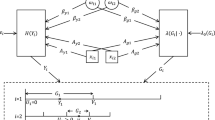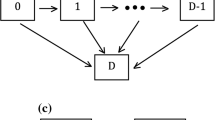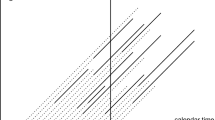Abstract
In this article, a more flexible and easily explained joint latent model with time-varying coefficients is used to characterize time-dependent responses and a failure time. The dependence within time-dependent responses and between time-dependent responses and a failure time, and the heterogeneity in both processes are established through partially non-parametric latent variables. Based on longitudinal and survival time data, an estimation procedure is proposed for the parameter functions of the joint latent model. In our estimation, the approximated likelihood is constructed via substituting the basis function expansions for parameter functions. The expectation and maximization (EM) algorithm is then implemented to obtain the maximizer of the approximated likelihood function, and, hence, the estimated parameter functions. The validity of the considered joint latent model enables us to derive the asymptotic properties of the estimated functions. Moreover, the corresponding finite sample properties and the usefulness of our methods are demonstrated through a Monte Carlo simulation and the AIDS Clinical Trials Group (ACTG) 175 data. A possible extension of our joint latent model and some additional topics of interest are also discussed herein.
Similar content being viewed by others
References
Brown ER, Ibrahim JG, DeGruttola V (2005) A more flexible B-spline model for multiple longitudinal biomarkers and survival. Biometrics 61: 64–73
Burnham KP, Anderson DR (2002) Model selection and multimodel inference: a practical information-theoretical approach, 2nd edn. Springer, New York
Cai Z, Sun Y (2003) Local linear estimation for time-dependent coefficients in Cox’s regression models. Scand J Stat 30: 93–111
Casella G, Robert CP (1996) Rao-Blackwellisation of sampling schemes. Biometrika 83: 81–94
Chiang CT, Rice JA, Wu CO (2000) Smoothing spline estimation for varying coefficient models with repeatedly measured dependent variable. J Am Stat Assoc 96: 605–619
Dempster AP, Laird NM, Rubin DB (1977) Maximum likelihood from incomplete observations. J Roy Stat Soc Ser B 39: 1–38
Fan JQ, Zhang JT (2000) Functional linear models for longitudinal data. J Roy Stat Soc Ser B 62: 303–322
Ghosh P, Vaida F (2007) Random changepoint modelling of HIV immunologic responses. Stat Med 26: 2074–2078
Gray RJ (1992) Flexible methods for analyzing survival data using splines, with applications to breast cancer prognosis. J Am Stat Assoc 87: 942–951
Guo X, Carlin BP (2004) Separate and joint modeling of longitudinal and event time data using standard computer package. Am Stat 58: 16–24
Hämmerlin G, Hoffmann K (1991) Numerical mathematics. Springer, New York
Hammer SM, Katzenstein DA, Hughes MD et al (1996) A trial comparing nucleoside monotherapy with combination therapy in HIV-infected adults with CD4 cell counts from 200 to 500 per cubic millimeter. New England J Med 335: 1081–1090
Henderson R, Diggle P, Dobson A (2000) Joint modeling of longitudinal measurements and event time data. Biostatistics 4: 465–480
Hodges JS, Sargent DJ (2001) Counting degrees of feedom in hierarchical and other richly parameterized models. Biometrika 88: 367–379
Hoover DR, Rice JA, Wu CO et al (1998) Nonparametric smoothing estimates of time-varying coefficient models with longitudinal data. Biometrika 85: 809–822
Huang JZ, Wu CO, Zhuo L (2002) Varying-coefficient models and basis function approximations for the analysis of repeated measurements. Biometrika 89: 111–128
Martinussen T, Scheike TH (2002) A flexible additive multiplicative hazard model. Biometrika 89: 283–298
Murphy S, Sen P (1991) Time-dependent coefficients in a Cox-type regression model. Stoc Proc Appl 39: 153–180
Strawderman R., Tsiatis AA (1996) On the asymptotic properties of a flexible hazard estimator. Ann Stat 24: 41–63
Tian L, Zucker D, Wei LJ (2005) On the Cox model with time-varying regression coefficients. J Am Stat Assoc 100: 172–183
Tsiatis AA, Davidian M (2001) A semiparametric estimator for the proportional hazards model with longitudinal covariates measured with error. Biometrika 88: 447–458
Tsiatis AA, DeGruttola V, Wulfsohn MS (1995) Modeling the relationship of survival to longitudinal data measured with error. Applications to survival and CD4 counts in patients with AIDS. J Am Stat Assoc 90: 27–37
Vaida F (2005) Parameter convergence for EM and MM algorithms. Stat Sin 15: 831–840
Wager CG, Vaida F, Kauerman G (2007) Model selection for penalized spline smoothing using Akaike information criterion. Aust N Z J Stat 49: 173–190
Winnett A, Sasieni P (2003) Iterated residuals and time-varying covariate effect in Cox regression. J Roy Soc Ser B 62: 473–488
Wu CO, Chiang CT, Hoover DR (1998) Asymptotic confidence regions for kernel smoothing of a varying coefficient model with longitudinal data. J Am Stat Assoc 93: 1388–1402
Wulfsohn MS, Tsiatis AA (1997) A joint model for survival and longitudinal data measured with error. Biometrics 53: 330–339
Zuuker DM, Karr AF (1990) Nonparametric survival analysis with time-dependent cvariates: a penalized partial likelihood approach. Ann Stat 18: 329–353
Author information
Authors and Affiliations
Corresponding author
Rights and permissions
About this article
Cite this article
Chiang, CT. A more flexible joint latent model for longitudinal and survival time data. Metrika 73, 151–170 (2011). https://doi.org/10.1007/s00184-009-0270-3
Received:
Published:
Issue Date:
DOI: https://doi.org/10.1007/s00184-009-0270-3




